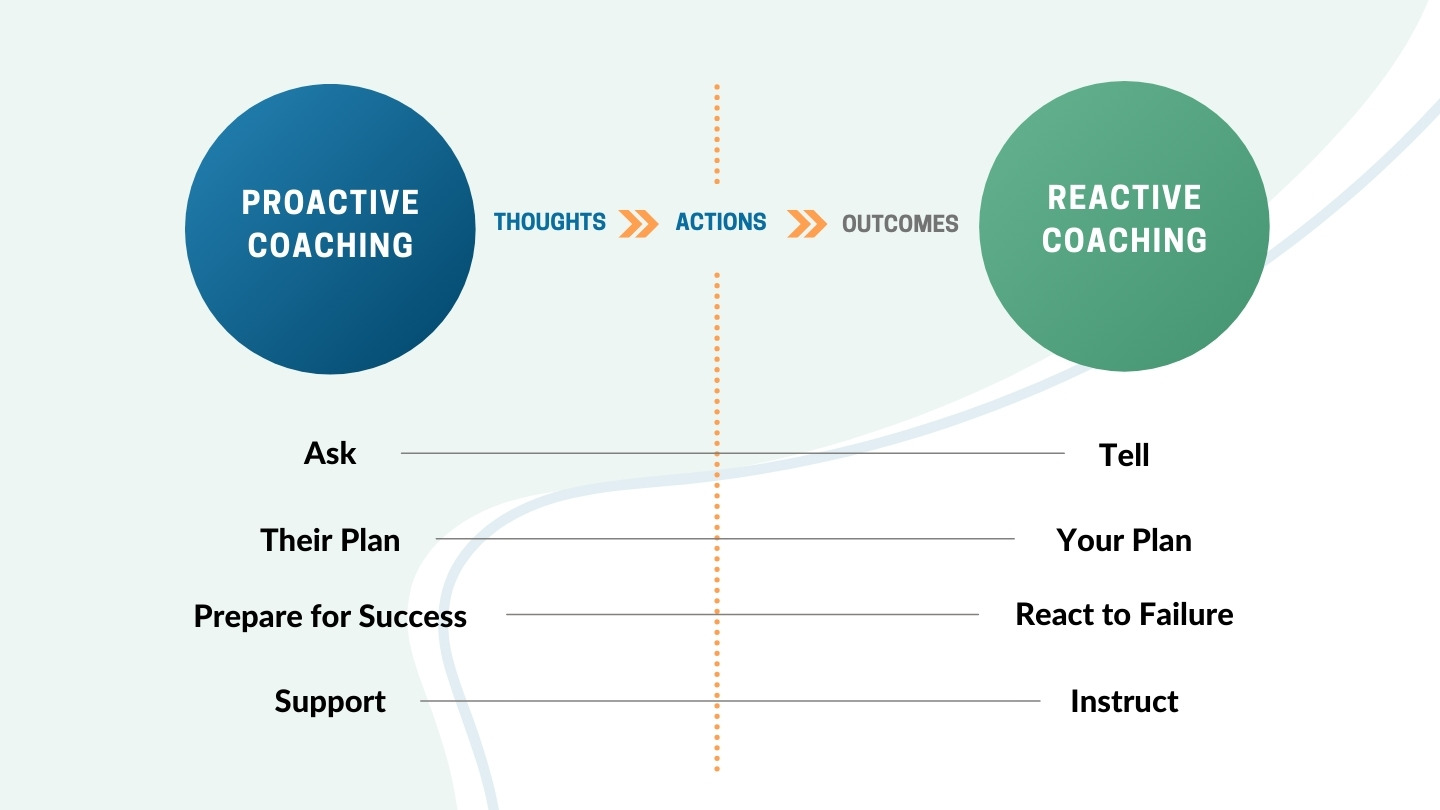Most coaching conversations in veterinary practices happen too late.
By the time a manager sits down with a team member, it’s usually to correct a mistake or talk through something that went wrong. This is coaching, but it’s the least effective - and most frustrating - kind. It puts leaders in a reactive role, always chasing problems instead of building success.
But there’s a better way. Proactive coaching isn’t just a leadership buzzword. It’s a practical shift that transforms your practice culture, reduces turnover, and makes your job as a manager easier and more rewarding. When you coach proactively, you invest in your team before the problems start. And over time, that investment pays off in a more engaged, accountable, and resilient veterinary team.
What Is Proactive Coaching?
Proactive coaching is about preparation, not repair.
Instead of waiting for something to go wrong and then stepping in, you help your team plan for success before they face challenges. This means more asking and less telling. It’s about working in the “thought space” with your team, helping them build a clear picture of what great performance looks like and supporting them as they figure out how to get there.
The best veterinary leaders don’t just hand over their own plan and expect compliance. They help their team members create their own version of success, and then they walk alongside them as a coach. When you do this, you help your team build ownership and motivation from the inside out.
Key elements of proactive coaching:
- Ask, don’t tell: Use questions to help your team think about how they can be at their best.
- Focus on the future: Spend more time talking about what’s possible than what went wrong.
- Prepare for success: Support team members as they make their own plans for improvement.
- Build clarity together: True clarity comes when people create their own vision of success, not just when they’re told what to do.
What Is Reactive Coaching?
Reactive coaching is what happens when leadership is driven by problems and mistakes.
In lots of veterinary practices, the only time team members hear feedback or coaching is after something has gone wrong: a missed weight entry, a mistake with medication, or an incomplete record. The conversation is focused on what wasn’t done right, and what needs to change.
This approach might feel efficient, but it’s actually exhausting. When leaders live in the outcome space, constantly reacting to errors, they’re always a step behind. Worse, this style of coaching rarely creates lasting change. Most of the time, people already know what went wrong. They don’t need more information; they need a process for doing it differently next time.
Signs you’re stuck in reactive coaching:
- Most feedback conversations start after a mistake.
- Coaching sounds like instructions or corrections.
- Team members feel nervous about being “called in” for a talk.
- You find yourself repeating the same reminders week after week.

The Science and Mindset Shift: Why Proactive Coaching Works
Behavior change doesn’t happen just because you tell someone what to do.
That’s not just an opinion; it’s what neuroscience tells us. People change when they can see, in their own mind, what good looks like and believe they can achieve it. When coaching is built around telling, you’re delivering your picture of success. When it’s built around asking, you’re helping them create their own.
Why Real Change in Your Veterinary Practice Starts in the Thought Space
Change doesn’t begin with new actions. It starts with new thoughts. Before anyone on your team can act differently, they need to think differently about the task in front of them. Once a person has built their own plan and can picture what success looks like, they’re much more likely to take new, effective action.
If coaching conversations always begin after something’s gone wrong, you’re skipping the part where real change takes root. You end up with compliance, not commitment. Most leaders in veterinary practice spend almost all their coaching time responding to problems instead of investing in what’s possible. But when you shift more of your coaching to focus on the thought space - helping your team build clarity and ownership ahead of time - you’ll see fewer mistakes, more progress, and a team that’s genuinely invested in doing their best work.
How to Shift from Reactive to Proactive Coaching

If you want to build a proactive coaching habit, start small. You don’t need to overhaul your whole leadership style overnight. Instead, look for opportunities each week to ask more and tell less, before the mistakes happen.
Steps to make the shift:
- Start with questions: The next time you’re about to give an instruction, pause and ask, “How do you want to approach this?” or “What does great look like to you here?”
- Let them build the plan: Help team members develop their own process for getting things right, rather than handing them yours.
- Prepare, don’t just repair: Set aside time in your schedule for proactive conversations, not just corrective ones.
- Reinforce and support: Follow up to celebrate wins, talk through challenges, and adjust plans as needed. Support is ongoing, not just a reaction to mistakes.
Overcoming Common Barriers
One of the most common objections to proactive coaching is, “I don’t have time for this.”
But the truth is you’re already spending time on coaching. The difference is whether you’re investing that time on the front end (helping your team get things right the first time) or on the back end (correcting problems, dealing with frustration, and managing turnover). Proactive coaching isn’t slower in the long run; it’s a time-saver and a stress-reducer.
And remember, this isn’t about being soft or letting people do whatever they want. It’s about building capability and confidence, so your team can operate at its best with less oversight and fewer reminders.
Build a Better Veterinary Team With Proactive Coaching
If you want a veterinary team that’s more engaged, more accountable, and more successful, start shifting your focus to proactive coaching. Ask more questions, let your team build their own version of success, and invest in them before things go wrong. The payoff is a culture where people are excited to grow, eager to take ownership, and proud to do their best work.
Try it this week: Pick one routine task or upcoming challenge, and instead of telling someone what to do, ask how they want to approach it. Support them as they create their plan, and see how the conversation - and the outcome - changes.
Change doesn’t happen because we issue instructions. It happens because people get clear, get invested, and get supported as they move forward. That’s the future of veterinary leadership, and it’s within reach for every practice willing to try something different.
What do you think? Other veterinary pros want to hear from you! Share your experience in the comments below.